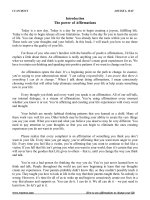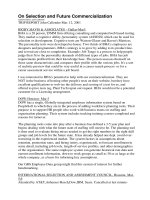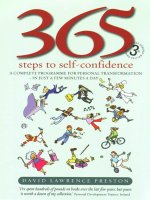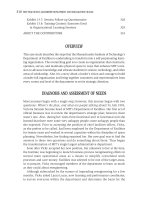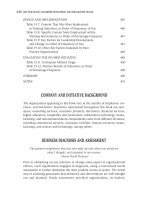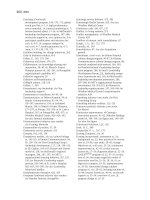Notes on Influencer to Change Anything_13 pdf
Bạn đang xem bản rút gọn của tài liệu. Xem và tải ngay bản đầy đủ của tài liệu tại đây (787.29 KB, 21 trang )
Become an Influencer 263
For instance, when it comes to your own health care,
here’s an interesting best practice. It’s wise to talk with your per-
sonal physician with the idea that any lingering symptoms you
experience might have more than one underlying medical
cause. Recent research into how doctors think reveals that
patients who say, “Yes, it sounds like I might have X, but could
there be something else going on as well?” are more likely to
resolve their overall health problems than those who hold to
the belief that if they treat one source of the problem, they will
be fine.
Left to our natural tendencies, most of us make poor use
of the vast array of the tools that can help improve performance.
When it comes to complex interpersonal skills, we rarely think
to make use of deliberate practice. For instance, in the fields
of leadership and interpersonal influence, students are rarely
taught specific behaviors that they can then rehearse while
receiving detailed feedback from a trained coach. In-
stead, students are taught “from the neck up” a set of ideas that
rarely leads to changes in behavior.
The ability to withstand yearnings and temptations is rarely
viewed as a skill. Instead, the ability to overcome enticements
is routinely attributed to inherent, DNA-driven personality
characteristics. Consequently, almost nobody actually practices
methods for delaying gratification. When people don’t believe
that the ability to withstand cravings is skill based, they rely on
every source of motivation imaginable. Eventually their
inevitable failure leads to depression and helplessness rather
than a search for newer and better skills.
Social capital also remains a largely untouched resource for
enabling change. Often we’re led to believe that battles need
to be won within the confines of one’s own heart. Heroes have
first and last names, not collective descriptors such as “team”
or “group.” Consequently, asking for help is seen as a weakness
rather as than a savvy strategy. Master influencers know better.
They identify those who need to be added to the change effort
264 INFLUENCER
in order to succeed. They make use of peer influence and
ensure that social circles support the effort rather than get in
its way.
When it comes to enabling performance by making use of
the physical world, most people typically fail to even think about
this powerful and yet largely untapped source of influence. Dr.
William F. Whyte came up with the idea of building the restau-
rant order spindle when he was dealing with restaurant argu-
ments, but nobody else thought of it. Dr. Frederick Steele
explained this mental gaff by suggesting that most of us are envi-
ronmentally incompetent. We rarely see the effect the physical
environment is having on us, nor do we make use of environ-
mental features when crafting an influence effort.
In short, you must address all six sources of influence when
designing an influence strategy. Stop thinking of influence tools
as a buffet, and recognize them as a comprehensive approach
to creating systematic, widespread, and lasting change. Di-
agnose both motivational and ability sources of influence, and
then lock in the results by applying individual, social, and struc-
tural forces to the solution. You now have a powerful six-
source diagnostic tool at your fingertips. Use it liberally.
MAKE CHANGE INEVITABLE
Let’s end on the concept of making change inevitable. More
than anything else, this characteristic sets effective influencers
apart from everyone else. Individuals who routinely hit their
change goals overdetermine vital behaviors in order to make
change inevitable, meaning that they routinely look at all six
sources, find methods from within each source, and continue
adding new influence strategies well after others have stopped
searching for change levers. They do this for a good reason.
Typically the change they’re attempting to orchestrate is so
audacious—so completely hopeless—that they pull out every
influence tool available.
Become an Influencer 265
PUTTING IT ALL TOGETHER
To see how the principles we’ve studied can be used in
combination in an actual business case, let’s take a look at
what we (the authors) once did when working with an ex-
ecutive team to solve a particularly destructive problem.
The leaders attempted to use each influence method we’ve
discussed to deal with the company’s inability to deliver on
commitments.
In this company, employees were good at making promises;
it was keeping them that gave them fits. With each new proj-
ect, senior managers set clear objectives, department heads
agreed to detailed specs and deadlines, and then one or more
groups fell miserably short of their goals and delayed the proj-
ect. This habit of always missing deadlines caused enormous
problems with customers. Delays and crisis recoveries caused
costs to spiral out of control. And the company’s growing rep-
utation for being “long on commitment but short on fulfill-
ment” was beginning to cost them dearly in the marketplace.
Old customers were fleeing while new ones were becoming
increasingly difficult to find.
To identify the self-defeating behaviors that were leading to
failure, a team consisting of several senior managers and the
authors conducted interviews with project managers and proj-
ect team members. The research team quickly discovered that
people were completely aware of consistent failures, as well as
the reasons for them.
Fact-Free Planning. One manager told us that corporate
executives would lay out plans without gathering facts about
what the team was actually able to accomplish. If they did ask
for input, it was just a joke because they already had the dead-
line in their heads. The manager explained, “More often than
not, we know from the onset that we’re going to fail because
we don’t have sufficient resources. Watching one of our proj-
ects unfold is like watching a ‘slow-motion train wreck.’ You
266 INFLUENCER
know that your project is going to end in disaster, and all you
can do is sit back and watch it tumble off the track.”
Project Chicken. Another manager explained how the
team played the same pernicious game we discussed earlier. “In
every planning and follow-up meeting,” she said, “project man-
agers say they’re right on spec and schedule, while in truth
they’re quietly praying that someone else will admit that he or
she is behind schedule so that person will take the heat while
everyone else is given a reprieve. It’s a deadly game that pits
managers against one another in a way that eventually crushes
our customers.”
AWOL Sponsors. Finally, we found that the organization’s
projects suffered when project sponsors were absent without
leave. Each project was assigned a senior leader whose job it
was to sponsor the project. The sponsor was supposed to help
guide the project through the organization as they and other
leaders competed for resources. If there was a problem, it was
the sponsor’s job to seek additional resources as required,
update key personnel, and otherwise smooth the skids.
The trouble in this organization was that sometimes
sponsors wouldn’t show up for meetings, wouldn’t enforce
agreements with other departments, and would fail to align
other leaders behind the teams’ decisions. The project team
was left hanging, and the project would inevitably come to
nothing.
One project, for example, burned up thousands of person-
hours and over a million dollars in precious resources, but
ended up on the scrap heap at the end. The most painful
part of the failure, however, wasn’t just the loss of time and
money. It was that halfway into the project everyone knew
it was doomed because the sponsor was doing nothing to
enforce commitments, gain support from stakeholders, and
maintain accountability. Everyone would show up to project
meetings, but they’d just play with their BlackBerries because
they knew the meetings were irrelevant!
Become an Influencer 267
Search for Vital Behaviors
To discover what it would take to turn around this culture of
fear and failure, we asked if there were any project managers
or team leaders who consistently hit their deadlines, and if so,
if we could watch them in action. It turned out there were. So
we and the executive team studied these positive deviants.
While studying these accomplished project managers, we
began to see why they hit their goals when others didn’t. For
instance, in one key meeting we watched a positive deviant
deal with Fact-Free Planning. A senior executive had commit-
ted to a deadline without ensuring that the organization could
deliver. When confronted with her misstep, the executive
became very defensive. She threatened to outsource the proj-
ect if the internal team “didn’t have the commitment required.”
That was when the magic happened. We watched this skill-
ful project manager deal with the defensive executive, refuse
to respond in kind, and calmly create a sense of shared purpose
between the project team and the executive. The manager left
the room with the backing of the executive for a far more real-
istic plan and, more importantly, with an agreement on how
future project commitments would be made.
Watching this woman along with other positive deviants
showed us that the vital behaviors for project success involved
dealing with what we later called “crucial conversations.” In fact,
we’ve found that being able to successfully hold crucial conver-
sations is frequently the vital behavior behind change. (Our book
Crucial Conversations: Tools for Talking when Stakes are High
teaches a very common set of vital behaviors—the ability to speak
and be heard and encourage others to do the same, no matter
how controversial, political, or unpopular one’s views.)
Having found our vital behaviors in this particular organi-
zation (the ability to hold crucial conversations about Fact-Free
Planning, Project Chicken, and AWOL Sponsors), it was our
job to use every means within our control to ensure the results
268 INFLUENCER
they wanted. What would it take to get everyone to enact these
behaviors and eventually turn the culture around?
Change How You Change Minds
We knew one thing for certain: Verbal persuasion wasn’t going
to offer much help. Telling people that they needed to speak
up when they disagreed with a person in authority or had bad
news sounded more like, “You need to naively expose your
problems, put your career at risk, and be seen as a whiney non-
team player. So go ahead—who wants to be first?”
What we needed to do was find a way to help people
change two specific views. First, they had to believe they could
indeed speak frankly without looking like rebels or wimps.
Second, they had to believe that if they did effectively share
their contrary or controversial ideas, they and their colleagues
would make the right choices about deadlines and resources,
and eventually they’d be able to actually hit their goals.
MAKE CHANGE INEVITABLE
To replace their existing fears with a growing sense of confi-
dence, employees didn’t need a lecture; they needed to
improve their actual skills (Personal Ability). To do so we took
the rather complex behaviors demonstrated by those who knew
how to make it safe to talk about just about anything, and fol-
lowed the tenets of deliberate practice. We broke the skills into
learnable parts and provided positive examples. As individuals
practiced the new skills within a protected training environ-
ment, they were given immediate feedback from a coach.
Finally, as they grew their competence they began to believe
that they could indeed speak their minds without taking a huge
risk.
But we didn’t stop there. We took care to connect the newly
acquired skill set to the trainees’ sense of who they wanted to
Become an Influencer 269
be as well as to their core values (Personal Motivation). People
weren’t being asked to learn skills merely because it was the lat-
est “flavor of the month;” they were being given the chance to
become the person they preferred to be. Nobody wanted to play
project chicken—essentially lying about their readiness while
wishing the worst on their peers. Consequently, as part of the
training experience people openly discussed the existing culture,
how it violated their values, and what it would take to become
a functioning team composed of professionals rather than, well,
a group of people who had originally described their culture as
one built on lies and deception.
In addition, we gave team leaders a firsthand view of the
human consequences of AWOL sponsorship and fact-free
planning. We had them spend a weekend in development—
seeing the problems thoughtless deadlines and lack of support
from leadership created for the personal lives of those who had
to meet the deadlines. At one point, an operations manager
confessed that his marriage was about to collapse because he
had not been home a full weekend for over a year. Members
of the leadership team left with a whole new level of moral
engagement.
To provide additional motivation to learn and implement
the vital behaviors, we tapped into the social support system
(Social Motivation). First we identified opinion leaders and
asked them to help lead the influence effort. They were the first
to go through the training. By learning firsthand that the train-
ing could help them resolve real problems they had been fight-
ing for years—and then seeing the enormous benefit of
learning and implementing the skills—opinion leaders openly
encouraged their coworkers to take part in the training and put
the skills into play. To transform mere words into a vicarious
experience, several told stories of how the skills had helped
them work through a touchy discussion.
To further enable each employee to routinely use the skills,
the training was always taught in intact teams by the team’s
270 INFLUENCER
immediate supervisor (Social Ability). The supervisor would
begin by forming participants into teams of three. After the
training was complete, the teams met and discussed what they
were doing to catch and solve problems early. They often gath-
ered over lunch, where members helped each other prepare
for an upcoming high-stakes conversation.
Managers provided additional incentive to routinely step up
to and master the vital behaviors by including the target behav-
iors in performance reviews linked to the annual bonus
(Structural Motivation). Employees were now measured against
the skills that were taught in the training. In addition, 25 per-
cent of senior executives’ bonuses were pegged to whether or not
they measurably improved the vital behaviors across the orga-
nization. That put real teeth into the intervention.
Finally, to make good use of the physical environment,
every meeting room displayed a poster that reviewed the skills
employees were supposed to bring into play when they faced
problems with project management (Structural Ability). Leaders
also included a short list of the vital skills at the top of their
printed agenda as a way of reminding themselves to review one
or more elements in each meeting. And then, to make good use
of the power of propinquity, two groups that routinely went at it
hammer-and-tong were moved to the same work area where con-
stant interaction helped them become far more collaborative.
By carefully considering each of the principles we’ve cov-
ered in this book, this particular change team was able to over-
come what had been an overwhelming problem. We know that
they succeeded because we measured the results. By taking a
pre-measure of the vital behaviors and then correlating
improvements in the behavior with key performance indicators,
the research team discovered that not only did the use of vital
behaviors increase substantially, but for each percentage
increase in the use of the vital behaviors, there was a $1.5 mil-
lion improvement in productivity. Quality and customer satis-
faction measures were similarly affected by improvements in
Become an Influencer 271
the vital behaviors. By applying each of the influence princi-
ples and strategies we’ve studied—and not just one or two
methods—the change team was able to resolve what had been
a massive and resistant problem. They had become genuine
influencers.
AN INVITATION FROM THE AUTHORS
Influencers not only overdetermine their results, but they also
rarely work alone. Massive problems require a community of
influencers working in concert. As an increasing number of
people apply the works of Bandura, Silbert, Hopkins, Berwick,
and other influence experts to problems of every kind, new and
vibrant influence communities are springing up each day.
By working with others to bring every influence tool imag-
inable to bear on their problems, this growing community of
experts has taught us not to be too quick to pray for serenity.
They have shown us that the combined power of their influ-
ence tools is far greater than the sum of the individual parts.
While turning criminals and addicts into healthy citizens, sav-
ing millions of lives, turning companies around, and annihi-
lating deadly diseases, they have taught us one of the most
important lessons we can ever learn. When you understand the
forces behind any behavior, along with the strategies to change
it, you hold within your grasp the power to change anything.
You too can find strength in numbers by joining the grow-
ing community of world-class influencers. Start by visiting our
Web site at influencerbook.com, where we’ll provide you with
a worksheet to help you prepare for and organize your next
influence project. At this site you can blog with other students
of influence who are working to solve challenges similar to
yours. You’ll also be able to learn more about vital behaviors
and six-source strategies, and view short segments of interviews
with a few of the influencers you’ve already met in this book.
272 INFLUENCER
Finally, if you’d like to take a measure of your existing influ-
ence skills, the site offers a self-assessment that not only gives
you a view into your existing influence repertoire but can also
help you develop the next steps for becoming an effective influ-
encer. Enjoy!
Additional Tools
and Resources
S
trengthen your influence skills today by visiting our Web
site at www.influencerbook.com. There you’ll find a vari-
ety of free resources that have been designed to help you
transform this book into a tool for change. Resources include:
Worksheet. Download a worksheet that you can use to
design and organize your next influence effort. This handy tool
helps you select a problem, identify vital behaviors, explore six-
source methods, and otherwise apply everything you’ve explored
in the book to a problem you’d like to resolve once and for all.
Blog. Join a growing community of individuals who are doing
their best to become the next generation of influencers. As you
tackle the persistent problems you face every day, you can blog
with other individuals who face challenges similar to your own.
Vital Behaviors and Six Sources. Discover what contempo-
rary researchers and practitioners are learning each day regard-
ing which behaviors lead to the greatest changes, as well as which
six-source methods suit you best. As you read the practical sug-
gestions of others, you can also contribute ideas of your own.
Video Interviews. View clips of some of the influence mas-
ters you’ve met in this book as they share their intriguing sto-
ries in candid, on-camera interviews. Use the video segments
for your own personal review or to stimulate a group or com-
munity discussion.
Self-Assessment. Take the Influencer Self-Assessment,
which will help you discover the strengths and weaknesses of
your current influence style, as well provide you with helpful
advice.
273
Copyright © 2008 by VitalSmarts, LLC. Click here for terms of use.
This page intentionally left blank
275
Works Cited
PART 1: THE POWER TO CHANGE ANYTHING
P. 6. YMCA pools: Kevin Trapani of Redwoods Insurance Group. Personal inter-
view with the authors.
P. 7. Detroit jobs: Louis Aguilar, “Michigan Needs Auto Industry to Rebound to
Help the State Out of Its Recession, Economist Says,” Detroit News, June 12, 2007.
P. 7. Toyota: Charles Fishman, “No Satisfaction at Toyota,” Fastcompany.com,
111 (January 2007): 82.
P. 8. Discussion of the proceedings of the 16th International AIDS Conference
was taken from the conference program found at:
PAG.aspx?.
P. 10. Muhammad Yunus: Phil Smith and Eric Thurman, A Billion Bootstraps:
Microcredit, Barefoot Banking, and the Business Solution for Ending Poverty (New
York: McGraw-Hill, 2007), Foreword, p. x.
P. 10. AIDS cases in Thailand: Reported by Prime Minister Shinawatra in his
opening speech at the 15th International AIDS Conference, Bangkok, Thailand,
July 11, 2004. Can be found at:
ThaiPM_15thAIDSConference_11Jul04.pdf.
1: You’re an Influencer
P. 13. Mimi Silbert: Personal interview with the authors, 2005. Any reference to
Mimi Silbert or the Delancey Foundation is drawn from this interview unless
otherwise cited.
P. 14. Delancey statistics: Ibid. Further discussion can be found at: http://port-
land.indymedia.org/en/static/prisonprograms.shtml, enhowerfoun-
dation.org/grassroots/delancey/.
P. 14. Anonymous attendee of Delancey Street. Personal interview with the
authors, 2005.
Copyright © 2008 by VitalSmarts, LLC. Click here for terms of use.
276 Works Cited
P. 15. Miguel Sabido: Arvind Singhal and Everett M. Rogers, Entertainment
Education: A Communication Strategy for Social Change (Mahwah, New Jersey:
Lawrence Erlbaum Associates, 1999), p. 55.
P. 17. Guinea worm: Donald Hopkins, personal interview with the authors, May
3, 2006. Any reference to Dr. Donald Hopkins, Guinea worm eradication, or The
Carter Center is drawn from this interview unless otherwise cited.
P. 19. Bobo Doll study: Albert Bandura, Dorothea Ross, and Sheila A. Ross,
“Transmission of Aggression through Imitation of Aggressive Models,” Journal of
Abnormal and Social Psychology, 63 (1961): 575–582.
P. 20. Albert Bandura: Personal interview with the authors, 2006. Any reference
throughout the book to Albert Bandura and his work is drawn from this interview
unless otherwise cited.
2: Find Vital Behaviors
P. 24. King’s birthday present: Praphan Phanunphack, interview with authors,
2006. Dr. Phanumphack is the director of the Red Cross AIDS Research Center
in Thailand. Additional information can be found at:
text/forum/bprisons/speeches/2_e.shtml.
P. 24. AIDS statistics: Anupong Chitwarakorn, Jai P. Narain, ed., “HIV/AIDS and
Sexually Transmitted Infections in Thailand: Lessons Learned and Future
Challenges,” AIDS in Asia: The Challenge Continues (New Delhi, India: Sage
Publications, 2004).
P. 24. Five million cases: Reported by Prime Minister Shinawatra in his opening
speech at the 15th International AIDS Conference, Bangkok, Thailand, July 11,
2004. Can be found at:
15thAIDSConference_11Jul04.pdf.
P. 25. Wiwat Rojanapithayakorn: Personal interview with the authors, 2006. Any
reference to Dr. Wiwat or the 100% Condom Campaign in Thailand is drawn
from this interview unless otherwise cited.
P. 25. Number of sex workers: K. Archavanitkul, “What Is the Number of Child
Prostitutes in Thailand?” Warasan Prachakon Lae Sangkhom, 7 (1999):1–9.
P. 28. Relationship failure: Howard J. Markman, Scott M. Stanley, and Susan L.
Blumberg, Fighting for Your Marriage (San Francisco: Jossey-Bass, 2001), p. 18.
P. 28. Divorce prediction: Howard Markman, personal interview with the
authors, 2006. Any reference throughout the book to Howard Markman and his
work is drawn from this interview unless otherwise cited.
P. 31. Ethna Reid: Personal interview with the authors, 2006. Any reference
throughout the book to Ethna Reid or her work is taken from this interview
unless otherwise cited.
Works Cited 277
P. 36. Regional medical center: This story is taken from a consulting project done
by the authors with an anonymous medical center.
P. 41. Guinea worm statistics: Ruth Levine and the What Works Working Group
with Molly Kinder, Millions Saved: Proven Successes in Global Health (Washing-
ton, DC: Center for Global Development, 2004), p. 91. Additional information is
reported on The Carter Center’s Web site:
guinea_worm/index.html.
P. 42. Weight Control Registry: Jane E. Brody, “Personal Health: Weight Loss Is
Possible,” New York Times. September 16, 1997.
3: Changing Minds
P. 46. Snake phobics: Taken from interview previously referenced. For further
info, see Albert Bandura, N. Adams, and J. Beyer, “Cognitive Process Mediating
Behavioral Change,” Cognitive Therapy and Research, 1 (1977): 287–310.
P. 54. Ven Conmigo: Arvind Singhal and Everett M. Rogers, Entertainment
Education: A Communication Strategy for Social Change (Mahwah, New Jersey:
Lawrence Erlbaum Associates, 1999), p. 55.
P. 54. Twende Na Wakati (Story of Mkwaju): Arvind Singhal, personal interview
with the authors, 2006. Any reference throughout the book to Arvind Singhal or
his work is taken from this interview unless otherwise cited.
P. 56. Results of Twende Na Wakati: Arvind Singhal and Everett M. Rogers,
Entertainment Education: A Communication Strategy for Social Change
(Mahwah, New Jersey: Lawrence Erlbaum Associates, 1999), pp. 152–171,
131–134.
P. 57. “Maude’s Dilemma”: Ibid., pp. 16, 17. For further discussion about
“Maude’s Dilemma,” see: />maude.htm.
P. 59. Contaminated water: Elizabeth Rattine-Flaherty, personal interview with
the authors, 2006.
P. 60 AIDS transmission: Arvind Singhal interview (details above).
P. 61. Lajos Egri. The Art of Creative Writing (New York: Kensington Publishing
Corp., 1965), pp. 18–19.
P. 62. Mirror neurons: Giacomo Rizzolatti et al., “Premotor Cortex and the
Recognition of Motor Actions,” Cognitive Brain Research, 3 (1996): 131–141.
For more info on the mirror neuron and the discovery thereof, see: http://www
.biocrawler.com/encyclopedia/Mirror_neuron.
P. 66. Scared Straight: A. Petrosino, C. Turpin-Petrosino, and J. Buehler, “‘Scared
Straight’ and Other Juvenile Awareness Programs for Preventing Juvenile
278 Works Cited
Delinquency,” The Campbell Collaborative Reviews of Intervention and Policy
Evaluations (Philadelphia: Campbell Collaboration, 2003).
P. 66. Gums: I. L. Janis and S. Feshbach, “Effects of Fear-Arousing
Communications,” The Journal of Abnormal and Social Psychology, 48 (1953):
78–92.
P. 68. Medical deaths: Don Berwick, personal interview with the authors, 2006.
Information is taken from a report by the National Academy of Science: Linda
Kohn et al., To Err Is Human: Building a Safer Health System (Washington, DC:
National Academies Press, 1999).
P. 68. Don Berwick: Personal interview with the authors. Any reference through-
out the book to Don Berwick or his work is taken from this interview unless oth-
erwise cited. To learn more about Josie’s story see: www.josieking.org.
P. 70. General Gowon: Personal interview with the authors, 2006.
PART 2: MAKE CHANGE INEVITABLE
P. 75. Information about the Guinea worm was taken from interviews with Dr.
Donald Hopkins and other personnel at The Carter Center.
4. Personal Motivation
P. 85. Terri: Mimi Silbert, personal interview with the authors. Mimi told many
stories of individuals who go through experiences similar to that of the fictional-
ized story of Terri.
P. 86. Scott Peck, The Road Less Traveled (New York: Simon and Schuster,
1978), pp. 213–214.
P. 87. Classical conditioning: I. P. Pavlov, translated and edited by G. V. Anrep,
Conditioned Reflexes: An Investigation of the Physiological Activity of the Cerebral
Cortex (London: Oxford University Press, 1927).
P. 88. Brian Wansink, Mindless Eating: Why We Eat More than We Think (New
York: Bantam Books, 2006).
P. 90. Daniel Gilbert, Stumbling on Happiness (New York: A. A. Knopf, 2006).
P. 91. Miguel Sabido: Arvind Singhal and Everett M. Rogers, Entertainment
Education: A Communication Strategy for Social Change (Mahwah, New Jersey:
Lawrence Erlbaum Associates, 1999), p. 55.
P. 92. Mihaly Csikszentmihalyi, Flow: The Psychology of Optimal Experience
(New York: Harper and Row, 1990), p. 51.
Works Cited 279
P. 94. Grigori Perelman: Greg Johnson, “The Math Was Complex, the
Intentions, Strikingly Simple,” New York Times, August 27, 2006.
P. 95. Lack of moral thinking: Patricia H. Werhane, “Engineers and Manage-
ment: The Challenge of the Challenger Incident,” Journal of Business Ethics, 10
(1991): 605.
P. 95. Ellen Langer, Mindfulness (Reading, Massachusetts: Addison-Wesley, 1989).
P. 96. Challenger launch: Micheal Gorman, Transforming Nature (Boston:
Kluwer Academic Press, 1998).
P. 97. Moral disengagement: Albert Bandura, “Social Cognitive Theory of Moral
Thought and Action,” Handbook of Moral Behavior and Development, Vol. 1.
(Hillsdale, New Jersey: Lawrence Erlbaum Associates, 1991). pp. 45–103.
P. 97. Pintos: Dennis Gioia, “Pinto Fires and Personal Ethics: A Script Analysis of
Missed Opportunities,” Journal of Business Ethics, 11 (1992): 379–389.
P. 97. Matthew T. Lee, “The Ford Pinto Case and the Development of Auto
Safety Regulations, 1893–1978,” Business and Economic History, 27 (1998), no. 2.
P. 97. M. Dowie, “Pinto Madness,” Mother Jones (September/October 1977).
P. 99. Connect to values: Stanton Peele, 7 Tools to Beat Addiction (New York:
Three Rivers Press, 2004), p. 24.
P. 101. One-word label: Albert Bandura, et al., “Disinhibition of Aggression
through Diffusion of Responsibility and Dehumanization of Victims,” Journal of
Personality and Social Psychology, 9 (1975): 253–269.
P. 104. Therapy length: William R. Miller and Stephen Rollnick, Motivational
Interviewing (New York: The Guilford Press, 2002), p. 5.
P. 105. Therapy type: Ibid., pp 6, 7.
P. 105. Motivational interviewing results: Ibid., pp. 220, 226.
P. 106. Ralph Heath: Personal interview with the authors.
P. 106. Ginger L. Graham, “If you Want Honesty, Break Some Rules,” Harvard
Business Review, April 2002, pp. 42–47.
5. Personal Ability
P. 112. Fundamental attribution error: Lee Ross, “The Intuitive Psychologist and
His Shortcomings: Distortions in the Attribution Process,” Advances in
Experimental Social Psychology Education (New York: Leonard Berkowitz
Academic Press, 1977).
280 Works Cited
P. 112. Lack of training transfer: Mary Broad and John Newstrom, The Transfer of
Training: Action-Packed Strategies to Ensure High Payoff from Training
Investments (Reading, Massachusetts: Addison-Wesley, 1992), p. 7.
P. 114. Mindset: Carol S. Dweck, Mindset: The New Psychology of Success (New
York: Random House, 2006).
P. 115. Marshmallow studies: W. Mischel, Y. Shoda, and P. Peake, “The Nature
of Adolescent Competencies Predicted by Preschool Delay of Gratification,”
Journal of Personality and Social Psychology, 54 (1988): 687–696. See also Y.
Shoda, W. Mischel, and P. Peake, “Predicting Adolescent Cognitive and Self-
Regulatory Competencies from Preschool Delay of Gratification: Identifying
Diagnostic Conditions,” Developmental Psychology, 26 (1990): 978–986.
P. 116. SAT scores: Daniel Goleman, Emotional Intelligence: Why It Can Matter
More than IQ (New York: Bantam, 1995), p. 82.
P. 116. S. S. Feldman and D. A. Weinberger, “Self-Restraint as a Mediator of
Family Influences on Boys’ Delinquent Behavior: A Longitudinal Study,” Child
Development, 65 (1994): 195–211.
P. 117. Mischel and Bandura: A. Bandura and W. Mischel, “Modification of Self-
Imposed Delay of Reward through Exposure to Live and Symbolic Models,”
Journal of Personality and Social Psychology, 2 (1965): 698–705.
P. 118. Deliberate practice: K. A. Ericsson, R. Th. Krampe, and C. Tesch-Römer,
“The Role of Deliberate Practice in the Acquisition of Expert Performance,”
Psychological Review, 100 (1993): 363–406.
P. 121. Thailand condom use: W. Rojanapithayakorn and R. Hanenberg, “The
100% Condom Programme in Thailand,” AIDS, 10 (1996): 1–7.
P. 122. Skill development: K. A. Ericsson and A. C. Lehmann, “Expert and
Exceptional Performance: Evidence on Maximal Adaptations on Task
Constraints,” Annual Review of Psychology, 47 (1996): 273–305.
P. 122. Ten years: Benjamin Bloom (ed.), Developing Talent in Young People
(New York: Ballantine, 1985).
P. 122. Correlation between time and skill level: Karl Anders Ericsson, et al.
(eds.), The Cambridge Handbook of Expertise and Expert Performance (New York:
Cambridge University Press, 2006).
P. 123. Roger Bacon: Ibid.
P. 123. Olympic swimming: We compared Johnny Weissmuller’s Olympic record
times to times of current high school swimming champions. For more informa-
tion visit: />P. 123. Deliberate practice techniques: Karl Anders Ericsson, et al. (eds.). The
Cambridge Handbook of Expertise and Expert Performance (New York:
Cambridge University Press, 2006), p. 699.
Works Cited 281
P. 124. Deliberate practice and feedback: Ibid., p. 532.
P. 124. Natalie Coughlin: M. Grudowski, “The Girl Next Door Is Hungry,”
Men’s Journal, 12 (2003): 72–73.
P. 126. Pills: Albert Bandura, personal interview with the authors, September 7,
2005.
P. 126. Free throws: T. J. Cleary and B. J. Zimmerman, “Self-Regulation
Differences during Athletic Practice by Experts, Non-Experts, and Novices,”
Journal of Applied Sport Psychology, 13 (2001): 185–206.
P. 127. Dating skills: S. L. Foster, et al., “Teaching Social Skills to Shy Single
Men,” The Family Journal, 5 (1997): 37–48.
P. 129. Hot/cool systems: J. Metcalf and W. Mischel, “A Hot/Cool System
Analysis of Delay of Gratification,” Psychological Review, 106 (1999): 3–19.
P. 129. W. Mischel, “Toward an Integrative Model for CBT: Encompassing
Behavior, Cognition, Affect, and Process,” Behavior Therapy, 35 (2004): 185–203.
P. 130. Children and delay of gratification: H. Mischel and W. Mischel. “The
Development of Children’s Knowledge of Self-Control Strategies,” Child
Development, 54 (1983): 603–619.
P. 132. Expectation and delay of gratification: W. Mischel and E. Staub, “Effects
of Expectancy on Working and Waiting for Larger Rewards,” Journal of
Personality and Social Psychology, 2 (1965): 625–633.
P. 133. Distraction and delay of gratification: W. Mischel and E. Ebbesen,
“Attention in Delay of Gratification,” Journal of Personality and Social
Psychology, 16 (1970): 329–337.
P. 133. Teaching skill of delay of gratification: A. Bandura and W. Mischel,
“Modification of Self-Imposed Delay of Reward through Exposure to Live and
Symbolic Models,” Journal of Personality and Social Psychology, 2 (1965):
698–705.
P. 133. Focus and delay of gratification: W. Mischel and E. Ebbesen, “Attention
in Delay of Gratification,” Journal of Personality and Social Psychology, 16
(1970): 329–337.
P. 137. Willpower and delay of gratification: P. Peake, M. Hebl, and W. Mischel,
“Strategic Attention Deployment in Waiting and Working Situations,”
Developmental Psychology, 38 (2002): 313–326.
P. 134. Cognitive reappraisal: J. J. Gross, “Emotion Regulation in Adulthood:
Timing Is Everything,” Current Directions in Psychological Science, 10 (2001):
214–219.
P. 134. Handwashing: Jeffrey Schwartz, Brainlock (New York: HarperCollins,
1996), p. 212.
282 Works Cited
6: Harness Peer Pressure
P. 139. Milgram obedience studies: Stanley Milgram, “Behavioral Study of
Obedience,” Journal of Abnormal and Social Psychology, 67 (1963): 371–378.
P. 139. Phil Zimbardo discusses Milgram’s experiments on the Web site http://
thesituationist.wordpress.com/2007/02/16/when-good-people-do-evil-%E2%80%93
-part-i/
P. 143. Obedience study with confederate: Stanley Milgram, Obedience to
Authority: An Experimental View (New York: Harper and Row, 1974).
P. 148. Everett Rogers and diffusion of innovations: Everett Rogers, Diffusion of
Innovations, 3rd ed. (New York: Free Press, 1983), pp. 15, 32–34, 54–56, 247,
258, 266, 271. The story about the “Guy in the Bermudas” was told by Rogers in
a lecture at Stanford University in the fall of 1982.
P. 148. Limey story: Don Berwick, “Disseminating Innovations in Health Care,”
JAMA (2003): 1969–1975.
P. 150. Tinka Tinka Suhk: Arvind Singhal and Everett M. Rogers, Entertainment
Education: A Communication Strategy for Social Change (Mahwah, New Jersey:
Lawrence Erlbaum Associates, 1999), pp. 1, 176, 58, 137.
P. 151. Barefoot doctors: Everett Rogers, Diffusion of Innovations, 3rd ed. (New
York: Free Press, 1983), pp. 326–328.
P. 152. E-mail support: Personal interview with Albert Bandura, 2006.
P. 152. Diabetics and social support: C. Y. Wang and M. M. Fenske, “Self-Care
of Adults with Non-Insulin-Dependent Diabetes Mellitus: Influence of Family
and Friends,” Diabetes Education, 22 (1996): 465–470.
P. 152. Social commitments: Kurt Lewin, “Forces behind Food Habits and
Methods of Change,” The Problem of Changing Food Habits: Bulletin of The
National Research Council (National Research Council and National Academy
of Sciences, Washington, DC, 1943), pp. 35–65.
P. 153. Parents’ influence: Brent L. Top and Bruce A. Chadwick, Rearing
Righteous Youth of Zion (Salt Lake City: BookCraft, 1998).
P. 153. Qualities of opinion leaders: Everett Rogers, Diffusion of Innovations, 3rd
ed. (New York: Free Press, 1983), pp. 15, 32–34, 54–56, 247, 258, 266, 271.
P. 157. Tinka Tinka Sukh: Arvind Singhal, personal interview with the authors,
2006.
Works Cited 283
P. 159. Silence Fails study: For more info, see VitalSmarts/Concourse Group.
.
7: Find Strength in Numbers
P. 168. Tanika’s story: A story told to one of the authors as a microcredit industry
leader.
P. 171. Muhammad Yunus and the Grameen Bank: Muhammad Yunus, Banker
to the Poor (Dhaka, Bangladesh: University Press, 1998), p. 12.
P. 172. Borrower stats: Grameen Bank at a Glance:
bank/GBGlance.htm.
P. 173. Statement of Professor Muhammad Yunus at the ITU World Information
Society Award Ceremony, May 17, 2006. Accessible at:
2006/award/statements/yunus.html.
P. 174. Friends: John Lennon and Paul McCartney, “With a Little Help from My
Friends,” Sgt. Pepper’s Lonely Hearts Club Band, 1967.
P. 175. Weight of ox: James Surowiecki, The Wisdom of Crowds (New York:
Doubleday, 2004), p. xiii.
P. 179. Soul City: Garth Japhet, personal interview with the authors, 2006.
P. 187. Network quotient: Don Cohen and Laurence Prusak, In Good Company:
How Social Capital Makes Organizations Work (Cambridge, Massachusetts:
Harvard Business School Press, 2001).
P. 188. Physicians: Atul Gawanda, Complications: A Surgeon’s Notes on an
Imperfect Science (New York: Picado, 2002), pp. 11–24.
P. 189. Tragedy of the Commons: William Forester Lloyd, Two Lectures on the
Checks to Population (Oxford, England: Oxford University Press, 1833).
P. 191. HIV/AIDS in Thailand: Wiwat Rojanapithayakorn, “100% Condom Use
Programme,” manuscript presented in Provo, Utah, 2006.
P. 191. Five million saved: As reported by Prime Minister Shinawatra in his open-
ing speech at the 15th International AIDS Conference, Bangkok, Thailand,
July 11, 2004. Can be found at:
ThaiPM _15thAIDSConference_11Jul04.pdf.
8: Design Rewards and Demand Accountability
P. 194. Rewarding Children: M. R. Lepper, D. Greene, and R. E. Nisbett,
“Undermining Children’s Intrinsic Motivation with Extrinsic Reward: A Test of
